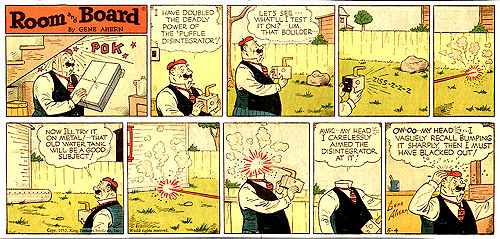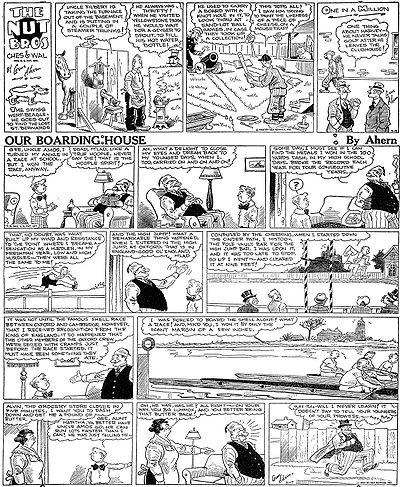
Gene Ahern
Encyclopedia

Our Boarding House
Our Boarding House was a long-running, American gag-panel comic strip created by Gene Ahern in 1921 and syndicated by Newspaper Enterprise Association. Set in a boarding house run by the sensible Mrs...
. Many of Ahern's comic strips took a surreal or screwball approach, notably "The Squirrel Cage" with its nonsensical catchphrase "Nov shmoz ka pop."
Ahern was born and raised in Chicago, attending public schools and working as a butcher boy, as noted in a 1929 newspaper article:
- Gene Ahern's path to the height of popularity in the comic world, started, strange as it may seem—in a meat market. True, he had been to art school before this, but it was his job as butcher's helper that gave real opportunity the first chance to knock. Gene spent his time making sketches on the long rolls of brown paper in which the shop's meat was wrapped. One day a man connected with a large fashion house came into the market for pork chops. Gene snipped them off and wrapped them up, using, by chance, a sheet of the paper he had previously covered with sketches. The customer eyed the package. “Who drew these?” he asked. “Oh, I did—just for the fun of it,” said Gene. Whereupon the customer suggested that it would be more fun to draw such pictures for money—and Ahern readily agreed that it would. The conversation continued and Gene told of his studies at art school and of his fondness for sketching. The stranger expressed interest and wound up by offering Gene a job in his fashion house art department. In his new job, he admits he hardly set the world on fire, but he learned a lot about drawing and that was what counted.
In his teens, he worked as a model, which he later recalled, "Daily, I slipped on cutaway coats, silk top hats and immaculate white gloves—and stood indolently in the front of a room while an artist sketched me for a catalogue."
Comic strips
After three years study at the Chicago Art Institute, Ahern went to Cleveland and worked for the NEA syndicateUnited Media
United Media is a large editorial column and comic strip newspaper syndication service based in the United States, owned by The E.W. Scripps Company. It syndicates 150 comics and editorial columns worldwide. Its core business is the United Feature Syndicate and the Newspaper Enterprise Association...
(1914-15) as a sportswriter and artist, initially inking comic drawings for $18 a week. He worked on such strips as Dream Dope, Fathead Fritz, Sporty Sid and his Pals, Taking Her to the Ball Game, Ain't Nature Wonderful, Squirrel Food, Balmy Benny and Otto Auto, about a man who loved driving so much that he couldn't stop. Comic strip historian Allan Holtz
Allan Holtz
Allan Holtz is a comic strip historian who researches and writes about newspaper comics for his Stripper's Guide, launched in 2005. His research encompasses some 7,000 American comic strips and newspaper panels...
described the transitions of these Ahern creations:
- In 1919, in his strip Squirrel Food, which was a pretty close copy of the look and humor of Rube GoldbergRube GoldbergReuben Garrett Lucius Goldberg was an American cartoonist, sculptor, author, engineer and inventor.He is best known for a series of popular cartoons depicting complex gadgets that perform simple tasks in indirect, convoluted ways. These devices, now known as Rube Goldberg machines, are similar to...
's strip, he introduced a new character, Otto Auto, on February 28. Originally Otto was a sprite who inhabited the background of the strip. Otto's schtick was that he drove his car like a bat out of hell and wouldn't let anything or anyone slow him down. Despite being relegated to the background, Otto quickly became the most popular feature of the strip. On July 20 Squirrel Food was renamed Otto Auto and the mad driver became the star of the show. Ahern made a daily game out of Otto's driving exploits, inviting readers to submit ideas for how to stop Otto's car. Every day Otto would encounter readers' traps and ambushes, and every day Otto would successfully avert them. This period of the strip was, for my money, one of the funniest slapstick sequences ever committed to newsprint... All good things must come to an end, though. Ahern knew that trying to make Otto Auto a series endlessly plying this single joke was a mistake. So it came that Otto's car was finally stopped and the strip moved to a garage where Otto and his second banana Clem traded jibes as fumbling mechanics... Otto Auto continued in this vein until February 6 1921, when the strip was replaced by Crazy Quilt.
The Nut Brothers
In 1921 he introduced the Nut Brothers, Ches and Wal, in Crazy Quilt. That same year, NEA General Manager Frank Rostock suggested to Ahern that he use a boarding house for a setting. Our Boarding House began September 16, 1921, scoring a huge success with readers after the January 1922 arrival of the fustian Major Hoople. The Nut Bros: Ches and Wal ran as a topperTopper (comic strip)
A topper in comic strip parlance is a small secondary strip seen along with a larger Sunday strip. In the 1920s and 1930s, leading cartoonists were given full pages in the Sunday comics sections, allowing them to add smaller strips and single-panel cartoons to their page.Toppers usually were drawn...
strip above Our Boarding House.
From Hoople to Puffle
Ahern was making an annual $35,000 at NEA, and King Features SyndicateKing Features Syndicate
King Features Syndicate, a print syndication company owned by The Hearst Corporation, distributes about 150 comic strips, newspaper columns, editorial cartoons, puzzles and games to nearly 5000 newspapers worldwide...
offered to double that figure. Leaving NEA in March 1936 for King Features, Ahern created Room and Board
Room and Board (comic strip)
Room and Board was a comic strip by Gene Ahern which was syndicated from 1936 to 1953, following Ahern's memorable Our Boarding House which he drew from 1921 to 1936.-Related strips:...
(1936-53). A resident in that boarding house was Judge Puffle, very much in the Hoople tradition.
Don Markstein traced the proliferation of Puffle and other Hoople variations:

- Knock-offs, such as Associated Press's Mister Gilfeather (which, by the way, was handled at various times by both Al CappAl CappAlfred Gerald Caplin , better known as Al Capp, was an American cartoonist and humorist best known for the satirical comic strip Li'l Abner. He also wrote the comic strips Abbie an' Slats and Long Sam...
and Milton CaniffMilton CaniffMilton Arthur Paul Caniff was an American cartoonist famous for the Terry and the Pirates and Steve Canyon comic strips.-Biography:...
, before they hit it big with Li'l Abner and Terry & the Pirates, respectively), began to proliferate. In fact, it was a knock-off that took Ahern away from his creation. King Features launched one called Room and Board, starring the very Hoople-like Judge Puffle, in 1936, and hired Ahern himself to write and draw it. This was a reprise of a move King had made nine years earlier, hiring George Swanson (Elza Poppin) to produce a duplicate of his own NEA strip, Salesman Sam, and it had a similar result—success, but not to the extent of the original. When, in 1953, Ahern retired, Room and Board ended. Today, its memory is overshadowed by its own topper, The Squirrel Cage, where the enigmatically familiar phrase, "Nov shmoz ka pop?" was introduced.
Radio
Our Boarding House was adapted into the radio series Major Hoople (1942-43). No copies of this radio series are known to exist.Influence
Ahern's The Squirrel Cage (1936-53), featured a bearded character known as The Little Hitchhiker, who became notorious for his frequent expression, "Nov shmoz ka pop?", which he uttered while thumbing for a ride. The character was the acknowledged inspiration for Robert CrumbRobert Crumb
Robert Dennis Crumb —known as Robert Crumb and R. Crumb—is an American artist, illustrator, and musician recognized for the distinctive style of his drawings and his critical, satirical, subversive view of the American mainstream.Crumb was a founder of the underground comix movement and is regarded...
's Mr. Natural
Mr. Natural (comics)
Mr. Natural is a comic book character created and drawn by 1960s counterculture and underground comix artist Robert Crumb. The character first appeared in the premiere issue of Yarrowstalks .-Characterization:...
.
Living in California for 36 years, Ahern resided at 1280 Stone Canyon in Los Angeles during the 1940s. He was a member of the Los Angeles Art Association, the Bel-Air Country Club, the Los Angeles Philharmonic Association and the National Cartoonists Society
National Cartoonists Society
The National Cartoonists Society is an organization of professional cartoonists in the United States. It presents the National Cartoonists Society Awards. The Society was born in 1946 when groups of cartoonists got together to entertain the troops...
. When he died of a heart attack in 1960, he was survived by his wife, Jane; a daughter, Mrs. Nancy Hayward of Clemmons, North Carolina
Clemmons, North Carolina
Clemmons is a village in Forsyth County, North Carolina and a suburb of Winston-Salem. The population was 18,627 at the 2010 census.-Geography:Clemmons is located at ....
; a sister, Mrs. Donald McCurdy; and three brothers, Walter, Harold and John, all of Chicago.

Sources
Strickler, DaveDave Strickler
Dave Strickler is a reference librarian noted for his compilation of Syndicated Comic Strips and Artists, 1924–1995: The Complete Index, regarded as a major reference work by researchers and historians of newspaper comic strips....
. Syndicated Comic Strips and Artists, 1924-1995: The Complete Index. Cambria, California: Comics Access, 1995. ISBN 0-9700077-0-1

